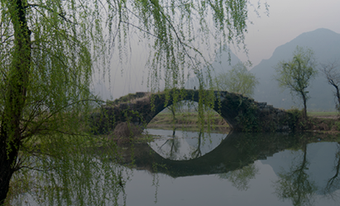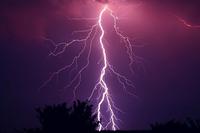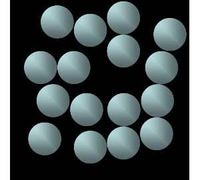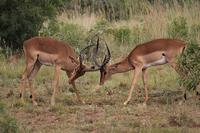Tao and Science

Featured Video:
I Ching and Binary Code: 2 to Infinity
As scientists describe how all individual systems within the universe are exchanging energy, we recognize the Taoist idea of 'the thread running through the way." In fact, the similarities between modern physics and the original ideas of Taoism led Niels Bohr, a pioneer of quantum mechanics to use the circular Yin and Yang image on his coat of arms, when knighted by the Danish King.
Read our Blog
All species thrive because of their interaction with one another, and are linked to interaction that we are just beginning to understand. In nature, everything is a blending of inseparable differences.
“In the great circle, there is no separation.”
When Einstein penetrated the secrets of the molecular world, he observed, “Nature does not distinguish between mass and energy but observes them to be one and the same.” His work transformed our understanding of the natural world, revealing our tendency to compartmentalize every aspect, as if each might exist independently. We are challenged when searching for isolated building blocks because of the intricate relationship of how each part is an observable variation of a larger whole.
“The successive movement of Yin and Yang
reveal the two modes of the One.”
The ancient Tao te Ching describes an evolutionary phenomenon that appears in two modes: Yin and Yang. “Their successive movement" resembles the force and field of electromagnetism. "The one produces the two" and fundamentally, force and field are intertwined. Like Yin and Yang, one cannot exist without the other.
Super String and M Theories are also reminiscent of the ideas of Taoism, and describe the universe in a multi dimensional language reduced to an oscillating wavelike particle (Yang) growing from a field (Yin.) When scientists use reductionism, they are attempting to conceptualize Tao.
The ancient masters taught: ‘something and nothing produce each other.’ We see this in the imploding singularity of the Big Bang. As this implosion reached critical mass, life was generated from a point of nothingness. What began, as unified symmetry in an incredibly hot universe is believed to have broken down into the four known forces.
In the cooling universe, elements came together and the possibility that life would emerge became a statistical phenomenon aided by what scientists call "deep time”. Over time, the impossible becomes possible; the possible moves toward becoming probable, and in the span of billions of years, the probable becomes almost certain.
Daily, physicists observe something emerging from nothing in the clashing particles of accelerator laboratories on earth. These experiments allow cosmologists to understand the first few seconds of the early universe. The equivalency of mass and energy is revealed each time particle collisions convert mass into energy, while mass reappears from ‘nowhere,’ out of only energy.
Our current models portray “the thread running through the way.” Unification portrays an undulating combination of waves and particles that move in multiple dimensions (visible and invisible) to become life. The ancient Chinese described this oscillating behavior before it became a tenet of modern physics.
The Taoist saw the universe as an organizing membrane, where each part became an observable snapshot of the unseen whole.
Like Yin, we observe attractive fields generated by magnetism and gravity. They are classified as negative because they pull. This negative force can be observed in the rippling waves that disturb a floating object by changing the shape of the surrounding water. In the same way, gravity changes the geometry of surrounding space to disturb the motion of moving planets.
Although we recognize a second force as being positive and productive because it pushes, these two forces are simply the successive movement of one phenomenon. Like Yang, electricity pushes a current through metal, but this pushing force is also the result of the pulling fields created by the exchange or movement of energy. It causes the metal to begin pulling, like Yin, as it becomes magnetic.
We know that any body influenced by a field is also a source of the field. If we throw a large object into the water, its weight will create waves that will also disturb the trajectory of the object that created the waves. This successive movement, or pushing and pulling behavior “reveals the two modes of the one.”
Read: Hidden Influences of the I Ching
Gravity demonstrates how the weight or inertial energy of a planet exerts a force, which pushes on space and yet, pulls other planets toward it. Like electromagnetism, the dynamics of gravity make it difficult to detect whether a force is actually pushing or pulling.
In our observations, we detect the outline of something generating itself in “two modes.” The pushing and pulling of various forces becomes fundamentally linked, underscoring the profound wisdom of ancient Taoist thought.
“The firm and yielding transform each other;
The high an low incline toward each other.”
The ancient text says: “the firm and yielding transform each other; the high and low incline toward each other.” We see this in high and low pressure systems. Yang is firm and represented as high, while Yin is yielding and embodied as low. Like electricity, the firm and yielding interact, and by virtue of this interaction, both types of energy are transformed.

When two unbalanced pressure systems collide or when lightning crosses the expanse of sky to ground itself in the earth, we observe how “the high and low incline toward each other.” High and low pressure systems are attracted to each other as weather systems balance temperatures across the earth.
Aspects of the natural world were said to be “seen and unseen.” As we view life in its duality, we see how particles (seen) are also waves (unseen,) and how kinetic energy (recognizable) is merely potential energy (unrecognizable) that has been released.
“Wander in the unfathomable.”
Similar to our inability to unify the four known forces, Tao is described as unfathomable. The Tao te Ching describes Tao as a type of flow, balance and interaction, and the exchange of energy between all living things and their environment.
Living things, such as seeds and human beings are dissipative structures, which must interact with the environment to survive. As self-organizing systems, they thrive within a universe that is moving toward entropy, randomness and disorganization. In the exchange of energy between the living thing and its environment, the entropy inherent in the universe is processed by way of these self-organizing systems.
Life can be viewed as a chain of sustenance from one species to another. It changes form in the movement and interaction between elements. If we could see life from nature's perspective, we would see all lines fading into one giant organism of sustenance and inter-dependency.
We observe interconnectivity when an atom goes from a higher to a lower energy state. It emits two photons, which fly away from the atom in opposite directions. Traveling at 186,000 miles per second, within moments, each can cover an incomprehensible distance. Yet, at any time, should a measurement be made on one photon, it will affect the second photon, even while it has traveled halfway across the universe.
In 1935, Schrodinger used the word ‘entanglement’ to describe how two parts of a system, separated by enormous distance and appearing independent, can remain connected. Studies in the late twentieth century proved entanglement to be a real phenomenon. This interconnectivity reveals each system to be connected to the structure of a higher organism.
In the energy exchange between systems, we observe how life forms develop unique defense mechanisms to achieve a sense of order in an environment of disorder or entropy. Entropy is the disorder that occurs as a statistical tendency within a system and can be observed in the way that molecules will disperse randomly inside an empty box.
Because there are more options available when we mix things up randomly, rather than if we were to sort them into specific categories, nature appears committed to the possibilities offered by disorder. This is because instability coaxes innovation and change.

Matter in equilibrium or stable is said to be 'blind,' while in non-equilibrium it begins to 'see.' In the same way, we can remain in the darkness of feeling attacked, or use non-equilibrium or conflict as the ‘light’ that allows us to access that part of us that remains in the dark.
Since the universe exists in a state of non-equilibrium, it appears to keep other systems from reaching equilibrium.
When two people meet or two molecules collide, both are altered by the encounter. Interaction transforms us and this alteration in our behavior leads to further innovations across groups of individuals. When molecules of one type are mixed with another, they are dispersed haphazardly and eventually blend to become something different. We see this when ink is dropped into water or when an idea like the Internet comes onto the scene haphazardly yet, transforms not only how we communicate but also, how we see ourselves.
Tao and Psychology
In a strange way, conflict or tension can be viewed as nature’s evolutionary mechanism that drives life toward innovation. Even in business, growth is only measurable when creative tension exists. Nature appears to create the most unusual pairings in an effort to explore variations. In some ways nature is merely balancing opposite energy. On a human level, this drive toward innovation leads us to become unique individuals. Sometimes we only discover what is important to us when we are forced to defend it.
In Taoism, the larger field of the universe becomes one’s larger body, with no sense of separation. Just as we do not recognize a person on the level of their individual molecules, but as a collection of interactive systems, some scientists describe life as emerging whole, collectively and as one large, living fabric. In the same way that we are more than our individual cells, the whole of the entity will always be more complex than its individual parts.
Observing this organizing membrane, called Tao led the ancient Chinese to describe it as both, the mover and the sum of its parts. In the push and pull of opposing energy, manifestation takes form in the productive thrust of Yang; it transcends temporal boundaries to dissolve into the boundless fields of Yin.
“Adaptation provides all living things with unique defense mechanisms.”
Biologically we are conservative creatures and even at the cellular level, we can observe our order-seeking tendency. Adaptation provides all living things with unique defense mechanisms that ensure their survival. In higher organisms, this is accomplished through the nervous system.
Our cells mirror how we interact with the world around us. They are individual units of life that conserve and thrive through reproduction. DNA carries the essence and character of an organism from generation to generation to achieve stasis for the long term. Cells exhibit behavior as growing, moving, dividing organisms, capable of adapting to extraordinary conditions. They respond to stimuli, recognize and communicate with other cells and are transformed by the genetic directions of the larger organism.

Geneticists present a picture of our genes that suggests how they may actually be using us as the host, as they push forward for survival. The fact that we are alive today, speaks to the determination of our genetic line. Yet, survival depends upon adaptability and while there is a natural process working to make us adaptable, another part of us pursues stasis. In a changing world, defense mechanisms allow us to make life manageable; to the Taoist, they only lead to self-imposed obstruction.
“One who desires not to be full can be newly made.”
________________________________
Did you know? The I Ching is a philosophical work assembled by the Masters of Taoism where natural processes are compared to the human condition. While it evolved as an oracle, in ancient times it was viewed as a philosophical study of empowerment by Taoist Masters. Learn about the I Ching in this video.
________________________________
Living things achieve a peculiar
orderliness in an environment of disorder..
To follow the way of nature, we must transcend our order-seeking tendency. Our need to create order can sometimes disconnect us from the flow arising from the 'larger host.' In Taoism, the inner and outer perspective become inseparable, and we observe ourselves moving within the flow of a larger structure.
Adaptation enables the organism to continue to interact with an environment that is always changing. These adaptation variations were implanted in us long ago, as a strange type of predetermination, where nothing new is added to the genetic mix. Everything we will ever need to survive can be found within, and we need only turn inward and empower it.
With nature as our teacher, Taoism coaches us to remain fluid, where we have a tendency to hold to the familiar. When we move forward with the past as our organizing center, we are oblivious to the unfolding relevance of the moment. Becoming open is fundamental to understanding how apparent conflict might lead us in our growth. This becomes the curriculum and the art of approaching change. While we may not be actively seeking conflict, when it appears, we recognize it as an opportunity to open and learn.
“Desire not to desire and learn to be without learning.
The way that leads forward appears to lead backward.”
Energy management describes how living organisms transform energy and store it, demonstrated by how fat is stored in tissues. The defense mechanisms of repression, transference and projection are the ways in which we transform or store latent psychic energy. We repress what we deem unacceptable, transfer or color our encounters based on past-experience, and project our unacknowledged inner life, as if another might hold the power to bring these unacknowledged feelings to our attention.
Conflict becomes an opportunity to transcend this past conditioning. Enormous energy can be returned to the present when we “desire not to desire and learn to be without learning.”
The ancient text says: “The way that leads forward appears to lead backward.” In the natural world, we observe a leaf floating in a river and when it meets obstruction, it begins to move in a circle. It portrays the movement of turning back and forward at the same time. Beyond the leaf and the obstacle is something that seeks continual movement. This can be viewed as the great river of Tao.
The defense mechanism of repression doesn’t happen just once; it is continuous. To keep something repressed requires a persistent expenditure of force, symbolized by the leaf, as it continually presses against the obstacle.
Tao can portray “the movement of turning back.” Sometimes we feel like we are being turned back or remain in a state of perceived crisis, until we are dislodged from clinging to our outworn perspective. Yet, Tao does not create the obstacle, we do. By virtue of its forward movement, it may appear that we are turning back, when in reality we are turned back because of the things we cling to.
When we remove or release the repressed idea or obstacle that we are defending, an enormous amount of energy is released, which is symbolized in the latent energy of this turning. By holding fast to the submissive, we can unleash the power of our unrecognized potential and “shape what the world will look and feel like for us.” This is the art of "becoming the master of our experiences."

"When meeting contention in another it is wise to look within."
Whatever the obstacle, we can be sure that it has relevance for us. It reflects something within, which has blocked our forward progress. “Turning back or becoming weak,” we do not press forward defensively, but become self-reflective and "all obstacles naturally disappear." Becoming supple, our forward movement will remain unimpeded.
Whether we are giving form to our fears or attempting to release dormant energy within, we are merely projecting untapped potential in a way that we might understand it. By taking ‘the path of least resistance,’ we become more observant when events appear to turn us back. By opening, we experience the flow as taking us exactly where we need to go. “That which goes against the way will come to an early end. Those who go against Tao end up being called unlucky.”
The wise know without going, see without looking,
and accomplish without doing.”
When we turn inward to find productive ways of transforming challenging situations into inner growth, we are inspired in a way that might move us beyond anxiety. Anxiety can be viewed as the potential energy locked in stagnation, as energy seeks to release itself. “Limpid and still, one can still be leader of the empire.” All of experience becomes our empire and once we master our inner processes, we will discover balance and wellness in the outer world.
The western philosopher, Nietzsche wrote: “the Truth is not accessible to our attempts at discovery; what thinking human beings characteristically do, in their pursuit of the Truth, is create their own truths.” He saw words as metaphors that classify ‘things’ to keep us trapped in images of the known. This orderly classification process is based on the past and keeps us from observing events as they unfold. The poet and philosopher William Blake wrote: “If the doors of perception were cleansed, everything would appear to man as it is: infinite.”
The sixty-four principles of the I Ching, suggest how nature can return us to our innocent awareness as natural creatures in the river of Tao.
Scientists have begun to approach uncertainty openly, in an effort to reach beyond our current knowledge. Similarly, Taoism coaches us toward a more all inclusive and holistic perspective that exists beyond our normal, perceptual boundaries.
Transcending our normal sense of boundaries, we have only begun to tap the mysteries presented by nature's more holistic perspective. This is the openness required to follow Tao. It is translated to mean "the gate through which all of life issues forth."
Our ability not to know allows us to approach the portal and actively discover.
